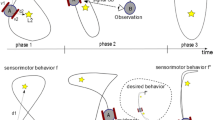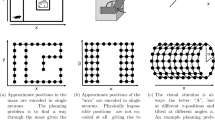Abstract
Animals for survival in complex, time-evolving environments can estimate in a “single parallel run” the fitness of different alternatives. Understanding of how the brain makes an effective compact internal representation (CIR) of such dynamic situations is a challenging problem. We propose an artificial neural network capable of creating CIRs of dynamic situations describing the behavior of a mobile agent in an environment with moving obstacles. The network exploits in a mental world model the principle of causality, which enables reduction of the time-dependent structure of real situations to compact static patterns. It is achieved through two concurrent processes. First, a wavefront representing the agent’s virtual present interacts with mobile and immobile obstacles forming static effective obstacles in the network space. The dynamics of the corresponding neurons in the virtual past is frozen. Then the diffusion-like process relaxes the remaining neurons to a stable steady state, i.e., a CIR is given by a single point in the multidimensional phase space. Such CIRs can be unfolded into real space for execution of motor actions, which allows a flexible task-dependent path planning in realistic time-evolving environments. Besides, the proposed network can also work as a part of “autonomous thinking”, i.e., some mental situations can be supplied for evaluation without direct motor execution. Finally we hypothesize the existence of a specific neuronal population responsible for detection of possible time-space coincidences of the animal and moving obstacles.
Similar content being viewed by others
References
Aitkenhead MJ, McDonald AJS (2006) The state of play in machine/environment interactions. Artif Intell Rev 25: 247–276
Barry C, Lever C, Hayman R, Hartley T, Burton S, O’Keefe J, Jeffery K, Burgess N (2006) The boundary vector cell model of place cell firing and spatial memory. Rev Neurosci 17(1–2): 71–97
Berg BC (1993) Random walks in biology. Princeton University Press, Princeton
Berg HC, Purcell EM (1977) Physics of chemoreception. Biophys J 20: 193–219
Collett TS, Zeil J (1998) Places and landmarks: an arthropod perspective. In: Healy S (eds) Spatial representation in animals. Oxford University Press, Oxford, pp 18–53
Craik K (1943) The nature of explanation. Cambridge University Press, Cambridge
Cruse H (2003) The evolution of cognition—a hypothesis. Cogn Sci 27: 135–155
Cruse H, Hübner D (2008) Selforganizing memory: active learning of landmarks used for navigation. Biol Cybern 99: 219–236
Hafting T, Fyhn M, Molden S, Moser MB, Moser EI (2005) Microstructure of a spatial map in the entorhinal cortex. Nature 436(7052): 801–806
Holland O, Goodman R (2003) Robots with internal models—a route to machine consciousness?. J Conscious Stud 10: 77–109
Hesslow G (2002) Conscious thought as simulation of behaviour and perception. Trends Cogn Sci 6: 242–247
Keymeulen D, Decuyper J (1994) The fluid dynamics applied to mobile robot motion: the stream field method. In: Proceedings of the IEEE international conference on robotics and automation, pp 378–385
Kuhn S, Cruse H (2005) Static mental representations in recurrent neural networks for the control of dynamic behavioural sequences. Connect Sci 17: 343–360
Kühn S, Cruse H (2007) Modelling memory functions with recurrent neural networks consisting of input compensation units: II. Dynamic situations. Biol Cybern 96: 471–486
Kühn S, Beyn WJ, Cruse H (2007) Modelling memory functions with recurrent neural networks consisting of input compensation units: I. Static situations. Biol Cybern 96: 455–470
Llinas RR (2001) I of the vortex: from neurons to self. MIT, second printing
Louste C, Liegeois A (2000) Near optimal robust path planning for mobile robots: the viscous fluid method with friction. J Intell Robot Syst 27: 99–112
Makarov VA, Song Y, Velarde MG, Hübner D, Cruse H (2008) Elements for a general memory structure: properties of recurrent neural networks used to form situation models. Biol Cybern 98: 371–395
McIntyre J, Zago M, Berthoz A, Lacquaniti F (2001) Does the brain model Newton’s laws?. Nat Neurosci 4: 693–694
Menzel R, Brandt R, Gumbert A, Komischke B, Kunze J (2000) Two spatial memories for honeybee navigation. Proc R Soc Lond B 267: 961–968
Mohan V, Morasso P (2007) Towards reasoning and coordinating action in the mental space. Int J Neural Syst 17: 329–341
Moser EI, Moser MB (2008) A metric for space. Hippocampus 18(12): 1142–1156
Moser EI, Kropff E, Moser MB (2008) Place cells, grid cells, and the brain’s spatial representation system. Ann Rev Neurosci 31: 69–89
Nekorkin VI, Velarde MG (2002) Synergetic phenomenon in active lattices: patterns, waves, solitons, chaos. Springer-Verlag, Berlin
Nekorkin VI, Makarov VA (1995) Spatial chaos in a chain of coupled bistable oscillators. Phys Rev Lett 74: 4819–4822
Nekorkin VI, Makarov VA, Kazantsev VB, Velarde MG (1997) Spatial disorder and pattern formation in lattices of coupled elements. Physica D 100: 330–342
O’Keefe J, Dostrovsky J (1971) The hippocampus as a spatial map. Preliminary evidence from unit activity in the freely-moving rat. Brain Res 34(1): 171–175
Rizzolatti G, Fogassi L, Gallese V (2001) Neurophysiological mechanisms underlying the understanding and imitation of action. Nat Rev Neurosci 2: 661–670
Savelli F, Yoganarasimha D, Knierim JJ (2008) Influence of boundary removal on the spatial representations of the medial entorhinal cortex. Hippocampus 18(12): 1270–1282
Schmidt GK, Azarm K (1992) Mobile robot navigation in a dynamic world using an unsteady diffusion equation strategy. In: Proceedings of the IEEE/RSJ international conference on intelligent robots and systems, pp 642–647
Sepulchre JA, MacKay RS (1997) Localized oscillations in conservative or dissipative networks of weakly coupled autonomous oscillators. Nonlinearity 10: 679–713
Sharma J, Dragoi V, Tenenbaum JB, Miller EK, Sur M (2003) V1 neurons signal acquisition of an internal representation of stimulus location.. Science 300: 1758–1763
Solstad T, Boccara CN, Kropff E, Moser MB, Moser EI (2008) Representation of geometric borders in the entorhinal cortex. Science 322(5909): 1865–1868
Steinkuhler U, Cruse H (1998) A holistic model for an internal representation to control the movement of a manipulator with redundant degrees of freedom. Biol Cybern 79: 457–466
Svensson H, Morse A, Ziemke T (2009) Representation as internal simulation: a minimalistic robotic model. In: Proceedings of the CogSci’09, 2890–2895
Taube JS, Muller RU, Ranck JB (1990a) Head-direction cells recorded from the postsubiculum in freely moving rats. I. Description and quantitative analysis. J Neurosci 10: 420–435
Taube JS, Muller RU, Ranck JB (1990b) Head-direction cells recorded from the postsubiculum in freely moving rats. II. Effects of environmental manipulations. J Neurosci 10: 436–447
Toussaint M (2006) A sensorimotor map: modulating lateral interactions for anticipation and planning. Neural Comput 18: 1132–1155
Umiltá MA, Kohler E, Gallese V, Fogassi L, Fadiga L, Keysers C, Rizzolatti G (2001) “I know what you are doing”: a neurophysiological study. Neuron 32: 91–101
Vergassola M, Villermaux E, Shraiman B (2007) Infotaxis as a strategy for searching without gradients. Nature 445: 406–409
Author information
Authors and Affiliations
Corresponding author
Rights and permissions
About this article
Cite this article
Villacorta-Atienza, J.A., Velarde, M.G. & Makarov, V.A. Compact internal representation of dynamic situations: neural network implementing the causality principle. Biol Cybern 103, 285–297 (2010). https://doi.org/10.1007/s00422-010-0398-2
Received:
Accepted:
Published:
Issue Date:
DOI: https://doi.org/10.1007/s00422-010-0398-2




